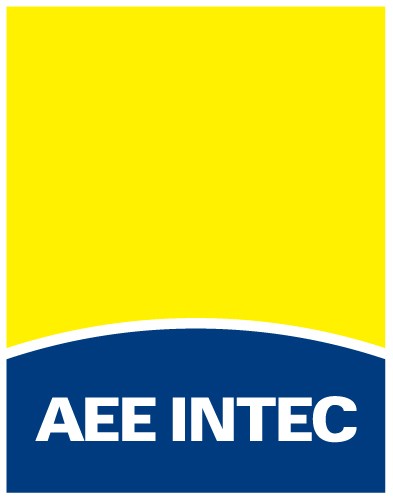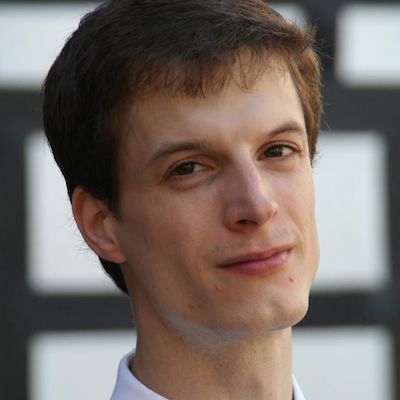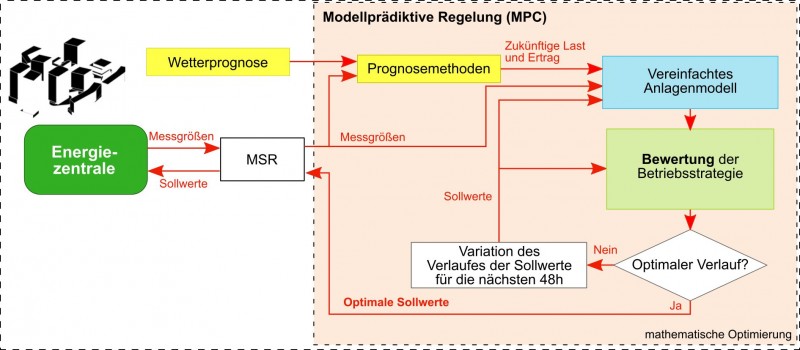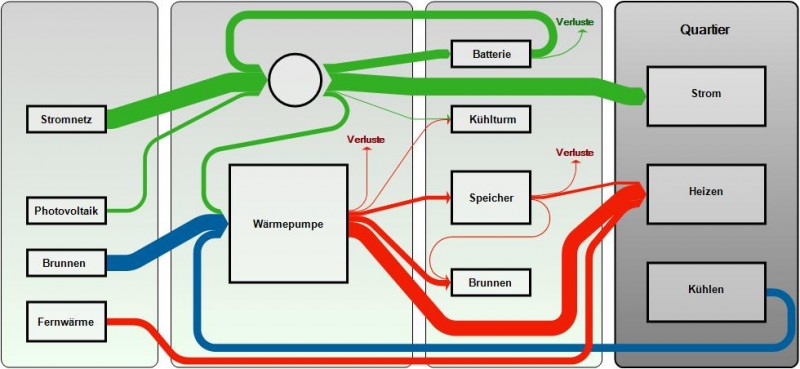ÖKO-OPT-QUART: Ökonomisch optimiertes Regelungs- und Betriebsverhalten komplexer Energieverbünde zukünftiger Stadtquartiere
Ausgangssituation/Motivation
In zukünftigen Stadtquartieren wird zunehmend auf die gezielte Kombination verschiedener, nach Möglichkeit erneuerbarer Energiequellen gesetzt. Die daraus entstehenden Energieverbünde werden aber zunehmend komplexer. Diese zunehmende Komplexität resultiert dabei im Wesentlichen aus der Abhängigkeit der regenerativen Energiebereitstellung von nicht beeinflussbaren, variierenden Umweltweinflüssen wie Wind und Sonne, der zunehmenden Dezentralisierung und dem steigenden Effizienzdruck. Die derzeit eingesetzten steuerungs- und regelungstechnischen Methoden sind jedoch nicht in der Lage derartig komplexe Systeme effizient und zuverlässig zu betreiben. Für die Entwicklung geeigneter Regelungsstrategien zur Sicherstellung eines robusten und effizienten Betriebsverhaltens komplexer Energiesysteme von Stadtquartieren werden zeitlich und räumlich hochgradig aufgelöste instationäre Simulationsmodelle benötigt, welche aufgrund der hohen Systemkomplexität bisher nur in Ansätzen verfügbar sind. Des Weiteren fehlt ein systematischer Zugang für die Praxis und Richtlinien, wie bei einem neuen Projekt und den damit verbundenen Voraussetzungen eine übergeordnete Regelung entwickelt und real umgesetzt werden kann.
Inhalte und Zielsetzungen
Im Projekt ÖKO-OPT-QUART wurden mithilfe eines energietechnischen und eines ökonomischen Simulationsmodells vorausschauende übergeordnete Regelungsstrategien erarbeitet und anhand einer konkreten Beispielkonfiguration (aktuell in Planung befindliches Stadtquartier) simuliert. Damit ist es bereits im Vorfeld möglich die Investitions-, Errichtungs- und Betriebsführungsstrategie mit dem größten wirtschaftlichen Nutzen zu identifizieren und zuverlässig zu bewerten. Ergänzend zu den methodischen Erkenntnissen wurde ein Sekundärnutzen generiert. Die Bewertung der Entwicklungen anhand realer Randbedingungen ermöglichte die gezielte Nutzung der gewonnen Erkenntnisse für die Realentwicklung des in Planung befindlichen Stadtquartiers.
Methodische Vorgehensweise
Im Projekt wurden energietechnische, ökonomische sowie regelungstechnische Modelle für komplexe Energieverbünde in Stadtquartieren entwickelt und anschließend für eine beispielhafte Konfiguration zu einem Gesamtmodell verknüpft. Die energietechnische Modellierung bildet das thermische sowie das elektrotechnische Verhalten eines urbanen Energieverbundes detailliert und zeitlich hoch aufgelöst ab. Die ökonomische Modellierung ermöglicht eine kontinuierliche ökonomische Bewertung der Betriebsweise, indem der zeitliche Verlauf der entstehenden Kosten abgebildet und analysiert werden kann. Die regelungstechnischen Modelle beinhalten je nach Ausführung eine konventionelle, dem Stand der Technik entsprechende, Regelung oder eine im Projekt entwickelte vorausschauende, kostenoptimierende Regelung für die Betriebsführung komplexer Energieverbünde in Stadtquartieren. Damit ist es möglich die Effizienz beider Regelungsstrategien in umfassenden Simulationsstudien zu vergleichen. Als Entwicklungsgrundlage wurde ein in Planung stehendes Quartier herangezogen. Die Integration der verantwortlichen Planer und Investoren hat die Modellentwicklung auf ein praxisnahes Fundament gestellt.
Ergebnisse und Schlussfolgerungen
Ziel des Projekts war die Entwicklung detaillierter und hoch aufgelöster instationärer Simulationsmodelle. Darauf aufbauend folgte die Kopplung dieser Teilmodelle zu einem interdisziplinären Gesamtmodell mit dem verschiedene Regelungsstrategien für den Energieverbund einer Beispielkonfiguration simuliert werden konnte. Durch dieses Gesamtmodell war es erstmals möglich, den ökonomischen Nutzen von vorausschauenden Regelungen für die Betriebsweise von Energieverbünden realistisch beziffern zu können. Des Weiteren wurde eine Methodik zur systematischen Entwicklung vorausschauender, kostenoptimierender Regelungen für komplexe Energieverbünde erarbeitet. Diese Methodik trägt dazu bei, fortschrittliche Regelungen für eine Vielzahl verschiedener Energieverbünde auf Quartiersebene zu erstellen. In den durchgeführten Simulationsstudien hat sich gezeigt, dass vor allem Speicher nötig sind um das volle Potential von vorausschauenden, kostenoptimierenden Regelungen auszuschöpfen. Das erzielte Einsparungspotential übersteigt die zusätzlich entstehenden Kosten (erhöhte Wartungs- und Installationskosten der Speicher) und somit zeigen die unter den angenommenen Randbedingungen durchgeführten Simulationsstudien eine mögliche Effizienzsteigerung (=Kostensenkung) des Gesamtsystems.
Ausblick
Eine kostengünstige Möglichkeit für die Speicherung von Energie ist die Nutzung von thermisch aktivierten Bauteilen. Ein möglicher nächster Schritt wäre daher die in diesem Projekt entwickelte modellprädiktive Regelung des Gesamtenergiesystems um die in der Gebäudestruktur wirkenden Regelungen – unter Berücksichtigung thermisch aktivierter Bauteile – zu ergänzen und zu einem umfassenden regelungstechnischen Gesamtkonzept zu vereinen. Somit könnte auf zusätzlich installierte thermische Speicher verzichtet werden was die Gesamtkosten des Systems weiter senken würde.
Projektvorstellung Stadt der Zukunft
Projektvolumen
EUR 741.679,-
Projektlaufzeit
2017-02-01 - 2019-01-31
Finanzierung
FFG (3. Ausschreibung Stadt der Zukunft) Stadt der Zukunft ist ein Forschungs- und Technologieprogramm des Bundesministeriums für Verkehr, Innovation und Technologie. Es wird im Auftrag des BMVIT von der Österreichischen Forschungsförderungsgesellschaft gemeinsam mit der Austria Wirtschaftsservice Gesellschaft mbH und der Österreichischen Gesellschaft für Umwelt und Technik ÖGUT abgewickelt. 
Projektpartner







Ansprechperson

Daniel MUSCHICK
daniel.muschick@best-research.eu
Area Management

Markus GÖLLES
markus.goelles@best-research.eu


